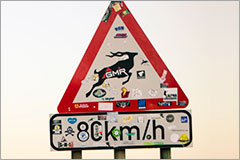How to Avoid Hitting Animals While Driving - Vol.314
One of the biggest dangers on the road can be animals that cross into roads and highways. It is important to be on the lookout for animals in the vicinity of the roadway and to be prepared for how to react when one enters the lane of travel. If you are not prepared for this eventuality you may overreact out of surprise which can lead to loss of control over your vehicle. It is important to remember that actually striking the animal may be the safer option and lead to less damage, than abruptly swerving or slamming on the brakes which can lead to a more significant accident.

Be Alert & On the Lookout
It is important to use the high beam setting on your vehicles headlights, especially when traveling on dark roadways or in rural areas. Using the bright setting on your headlights can illuminate a wider area and can help alert animals to the presence of your car. When driving you should be scanning the roadway ahead of you, as well as the area on either side of the road itself. When looking for potential hazards it can be helpful to watch for the bright reflection of animals eyes, as this is often the most visible part of an animal in your headlights. If you see one animal there are likely more in the area, so it is best to slow down and scan for more animals in the immediate area of where you spot a first one.
Many animals are more active at night, which can increase the likelihood of encountering them in the roadways especially when there is less traffic to deter their presence. Your visibility is also reduced in the dark, which can reduce your chances for seeing and reacting to animals near the road. Driving too fast or with excessive speed can increase the chances that an animal does not see your on-coming vehicle or that you do not see the animal. Always drive at the recommended speed limit and keep watch for roadway signs that alert you to the presence of animals in the area and suggest reduced speed.
What to do if an Animal Crosses Your Path
As soon as you notice the presence of any animals near the road it is important to slow down to allow the animals time to react to your moving vehicle and to reduce the damage of any impact that might occur. The behavior of the animal can be entirely unpredictable, so it is important to reduce speed or come to a complete stop if you can do so safely. Stopping fully in the traveling lane can be dangerous, so turn on your four-way emergency flashers and attempt to safely maneuver the vehicle to the shoulder or out of the traveling lane. It can be courteous to flash your headlights to other drivers if you have passed through an area where there were animals, which will likely cause them to more alert to what lays ahead of them.
If you are unable to fully avoid hitting an animal, then slow your vehicle safely without jamming on the brake and maintain focus on safely maneuvering your vehicle during the collision. Animal bones and antlers can cause significant damage to your vehicle, so it is important to pull over once it is safe to do so and inspect your vehicle for any damage. If you have struck an animal while driving, it is also important to alert the police so they can send animal control to take care of the body. Do not attempt to remove the body yourself as the animal may still be alive and likely to attack or react violently.